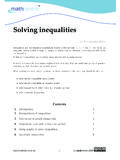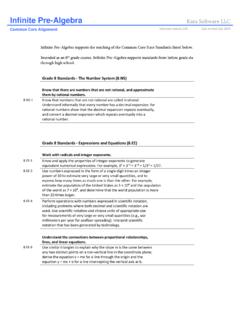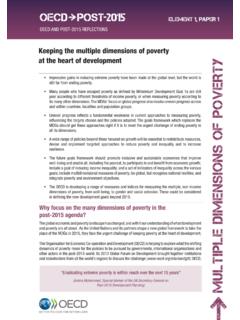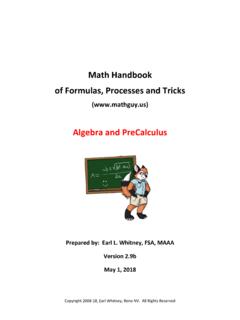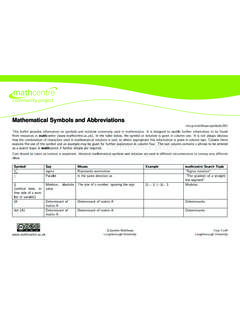Transcription of Sixth Grade Mathematics Supplement - …
1 Sixth Grade Mathematics Supplement For the 2012 Mathem atics Cour se of Study What is the purpose of this document? This document is intended to help educators understand what the new Mathematical Practice Standards and the Critical Areas mean a student must know, understand, and be able to do. This document, Ohio Department of Education s Model Curriculum, and school and Diocesan resources, can be used to understand can teacher the Common Core State Standards. What is in the document? Within this document you will find Grade level specific descriptions of what the mathematical practices mean a student should know, understand, and be able to do. What if I want to send feedback?
2 While every effort has been made to create examples that are helpful and specific, we are sure that as teachers use this, they will find ways to improve the document. Please send your feedback to and we will use your input to make this document even better. Sixth Grade Mathematics Supplement 2 Sixth Grade Critical Areas Critical Areas are the big ideas that educators can use to build the curriculum and guide their instruction. The Critical Areas for Kindergarten can be found on page 49 of the 2012 Mathematics Course of Study. 1. Connecting ratio and rate to whole number multiplication and division and using concepts of ratio and rate to solve problems. Students use reasoning about multiplication and division to solve ratio and rate problems about quantities.
3 By viewing equivalent ratios and rates as deriving from, and extending, pairs of rows (or columns) in the multiplication table, and by analyzing simple drawings that indicate the relative size of quantities, students connect their understanding of multiplication and division with ratios and rates. Thus students expand the scope of problems for which they can use multiplication and division to solve problems, and they connect ratios and fractions. Students solve a wide variety of problems involving ratios and rates. 2. Completing understanding of division of fractions and extending the notion of number to the system of rational numbers, which includes negative numbers.
4 Students use the meaning of fractions, the meanings of multiplication and division, and the relationship between multiplication and division to understand and explain why the procedures for dividing fractions make sense. Students use these operations to solve problems. Students extend their previous understandings of number and the ordering of numbers to the full system of rational numbers, which includes negative rational numbers, and in particular negative integers. They reason about the order and absolute value of rational numbers and about the location of points in all four quadrants of the coordinate plane. 3. Writing, interpreting, and using expressions and equations.
5 Students understand the use of variables in mathematical expressions. They write expressions and equations that correspond to given situations, evaluate expressions, and use expressions and formulas to solve problems. Students understand that expressions in different forms can be equivalent, and they use the properties of operations to rewrite expressions in equivalent forms. Students know that the solutions of an equation are the values of the variables that make the equation true. Students use properties of operations and the idea of maintaining the equality of both sides of an equation to solve simple one-step equations. Students construct and analyze tables, such as tables of quantities that are in equivalent ratios, and they use equations (such as 3x = y) to describe relationships between quantities.
6 Sixth Grade Mathematics Supplement 3 4. Developing understanding of statistical thinking. Building on and reinforcing their understanding of number, students begin to develop their ability to think statistically. Students recognize that a data distribution may not have a definite center and that different ways to measure center yield different values. The median measures center in the sense that it is roughly the middle value. The mean measures center in the sense that it is the value that each data point would take on if the total of the data values were redistributed equally, and also in the sense that it is a balance point. Students recognize that a measure of variability (inter-quartile range or mean absolute deviation) can also be useful for summarizing data because two very different sets of data can have the same mean and median yet be distinguished by their variability.
7 Students learn to describe and summarize numerical data sets, identifying clusters, peaks, gaps, and symmetry, considering the context in which the data were collected. Students in Grade 6 also build on their work with area in elementary school by reasoning about relationships among shapes to determine area, surface area, and volume. They find areas of right triangles, other triangles, and special quadrilaterals by decomposing these shapes, rearranging or removing pieces, and relating the shapes to rectangles. Using these methods, students discuss, develop, and justify formulas for areas of triangles and parallelograms. Students find areas of polygons and surface areas of prisms and pyramids by decomposing them into pieces whose area they can determine.
8 They reason about right rectangular prisms with fractional side lengths to extend formulas for the volume of a right rectangular prism to fractional side lengths. They prepare for work on scale drawings and constructions in Grade 7 by drawing polygons in the coordinate plane. Sixth Grade Mathematics Supplement 4 The Standards for Mathematical Practice The Common Core State Standards for Mathematical Practice are expected to be incorporated into every Mathematics lesson for every student in grades kindergarten through twelfth Grade . Below are examples of how these can be used in the tasks the students complete. Practice Explanation and Example Make sense and persevere in solving problems In Grade 6, students solve problems involving ratios and rates and discuss how they solved them.
9 Students solve real world problems through the application of algebraic and geometric concepts. Students seek the meaning of a problem and look for efficient ways to represent and solve it. They may check their thinking by asking themselves, What is the most efficient way to solve the problem? , Does this make sense? , and Can I solve the problem in a different way? Reason abstractly and quantitatively In Grade 6, students represent a wide variety of real world contexts through the use of real numbers and variables in mathematical expressions, equations, and inequalities. Students contextualize to understand the meaning of the number or variable as related to the problem and decontextualize to manipulate symbolic representations by applying properties of operations.
10 Construct viable arguments and critique the reasoning of others In Grade 6, students construct arguments using verbal or written explanations accompanied by expressions, equations, inequalities, models, and graphs, tables, and other data displays ( box plots, dot plots, histograms, etc.). They further refine their mathematical communication skills through mathematical discussions in which they critically evaluate their own thinking and the thinking of other students. They pose questions like How did you get that? , Why is that true? Does that always work? They explain their thinking to others and respond to others thinking. Model with Mathematics . In Grade 6, students model problem situations symbolically, graphically, tabularly, and contextually.



